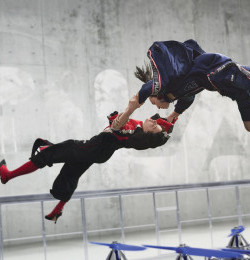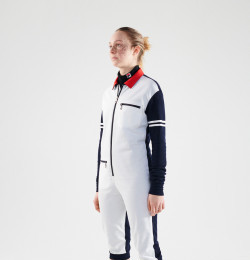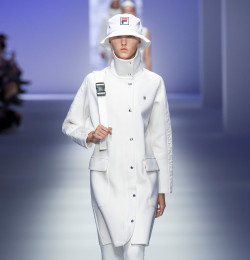

Fila
Sparks, MD 21152
USA
About
founded by
Fila brothers
belongs to
Fila Korea
about
Fila is Italy's largest sportswear manufacturing company, founded in 1911 in Italy, but now based in South Korea. Fila is headed by chairman and CEO Yoon-Soo Yoon. It now has offices in 11 countries worldwide.
Fila Holding S.p.A. is a major designer and marketer of athletic and casual footwear, activewear, casual wear, and sportswear for men, women, and children. In footwear, the company's best-selling categories are running, cross-training, basketball, and tennis; in apparel, tennis and winter sports are two of Fila's top categories. Other Fila products include sunglasses, watches, underwear, golf clubs, and in-line skates. In addition to the flagship Fila brand, the company also sells a line of leisure apparel and accessories aimed at young people aged 15 to 28 under the Enyce and Lady Enyce brands and markets the CIESSE brand of sports clothing in Italy. Fila does not manufacture any of its products but rather farms production out to independent subcontractors, mainly in the Far East. The company sells its products in more than 50 countries around the world both through directly controlled subsidiaries and via licensing and other distribution deals, reaching about 8,200 unaffiliated retail stores. Fila also directly owns and operates 18 boutiques and 61 outlet stores in several key markets, including Italy, France, the United Kingdom, the United States, Canada, and South Korea.
history
Fila was established in 1923 by eponymous brothers to manufacture knitwear, specifically underwear. The company operated in this field for nearly a half-century, enduring the Great Depression, political upheavals, and high inflation throughout the ensuing decades. It was not until the 1970s and the arrival of managing director Enrico Frachey that the company began to take its present shape. Frachey, who served the company from 1974 to 1979, has been credited with transforming Fila into a manufacturer of athletic apparel. An endorsement contract with tennis star Bjorn Borg proved particularly important to the company's successful penetration of high-end markets for tennis and skiwear. Over the course of the decade, Fila rode a rising tide of popularity into country clubs and onto the ski slopes of Europe and the United States. Although it did not become a runaway hit, Fila and its trademark "F" logo were widely recognized throughout the world of sports apparel and footwear by the end of the 1970s. Frachey left the company late in the decade.
During the 1980s, Italian fiber company SNIA BPD S.p.A. acquired an 80.5 percent stake in Fila, while the remaining 19.5 percent was owned by Unione Manifatture S.p.A., a holding company. Fila built a global network of licensees over the course of the decade and concurrently switched from backing athletes to sponsoring athletic events. The most important of the licensees proved to be America's H. Altice Marketing Inc., which was established in 1984 by former Converse executive Homer Altice and was selling 75,000 pairs of Fila shoes annually by its second year in business. Altice targeted his product at Fila's traditional upper-crust constituency, restricting distribution to such high-end retailers as Macy's, Nordstrom, and Neiman-Marcus and such specialty shops as Foot Locker. By 1987, the U.S. licensee's sales totaled 55 million. The brand went into a tailspin in the late 1980s, however, following a serious misstep. According to a 1988 piece in WWD, 15 million in Italian overstocks sold to a British liquidator ended up in the United States. The heavily discounted shoes undercut Fila's top-shelf image and flattened U.S. sales.
In the meantime, tennis, ski, and swimwear had continued to be Fila's mainstays; footwear was little more than an afterthought, generating only 7 percent of revenues in 1988. Although the parent company's sales had increased from L 150 billion ($78.5 million) in 1984 to L 180 billion ($138 million) in 1988, Fila suffered several annual losses mid-decade, culminating in a L 7.8 billion ($6 million) shortfall in 1987. SNIA rehired Frachey that year, and the "new" managing director immediately undertook a L 10 billion ($7.6 million) restructuring that included an endorsement contract with tennis luminary Boris Becker, a revamp of the company's design team, and ongoing management shakeups. In 1988, SNIA and Unione Manifatture sold their interests in Fila to Gemina S.p.A., a holding company that was in turn controlled by Italian automaker Fiat S.p.A., for L 62 billion ($47 million).
Fila completed a buyout of its U.S. license in 1991, thereby acquiring that company's $70 million in annual sales. The move signaled a shift in geographic emphasis to the all-important U.S. market and a focus on athletic footwear, particularly basketball shoes. Although Fila had long targeted upper-middle-class whites, the company found that young urban blacks had by the early 1990s become its core constituency.
As they had been in the 1970s, sponsorships were vital to Fila's success 20 years later. In 1994 the company inked an endorsement contract with Grant Hill of the NBA's Detroit Pistons. After he won 1995's Rookie of the Year award, sales of his namesake shoe skyrocketed to more than 1.5 million pairs. The brand continued its youth appeal with the 1995 addition of NBA rookie Jerry Stackhouse to its roster. From 1990 to 1995, U.S. sales as a percentage of overall Fila revenues went from 22 percent to 60 percent. Frachey also turned past growth strategies upside down. In 1990, footwear constituted only 14 percent of annual sales, with the remainder coming from clothing. By 1995 athletic shoes contributed more than 60 percent of revenues.
This combination of strategies helped make Fila America's fastest-growing footwear brand mid-decade, with U.S. sales burgeoning from $70 million in 1991 to almost $386 million, for a 6 percent share of this all-important market in 1995. The brand leapfrogged its second-tier competitors, growing from an eighth place ranking among the world's athletic shoe makers to number three by 1996.
Having established itself in the number three spot in the key footwear segment, Fila focused on parlaying its shoe success into continued growth by refocusing on apparel and accessories, diversifying into new sports, targeting women, emphasizing technology, and pursuing geographic expansion. Backed by the L 90 billion ($56 million) raised in a 1995 stock offering, the company invested in a variety of initiatives with a view to achieving L 2 trillion ($1.4 billion) in revenues in 1997.
Fila developed clothing for skiers, snowboarders, skateboarders, and baseball players, and concentrated on building its presence in specialized footwear for basketball, cross-training, running, hiking, volleyball, soccer, and tennis. It also established a joint venture with Italian eyewear manufacturer De Rigo S.p.A. to produce a branded line of sunglasses. Fila even created a skin care line including sun lotions and bath products. The company hired a slew of endorsers to support its new sports lines, including beach volleyball player Randy Stoklos, marathon runner German Silva, soccer players Claudio Reyna and Franco Baresi, and tennis player Marc Philippoussis.
The diversification also re-emphasized high-end sportswear and casual footwear with a particular focus on the long-neglected women's market. In 1995 Fila bought market share and expertise in women's and children's clothing via the acquisition of French sportswear manufacturer Dorotennis S.A. The parent company hoped to expand this new subsidiary from its European base into the United States and Asia.
Fila fought the perception that it was a "fashionable but low-tech" brand by establishing a research and development center in Portland, Oregon, and staffing it with engineers hired away from Nike. Fila's 1996 annual report stressed the strategic shift, asserting, "Style is our heritage. Creativity is our strength. Technology is our future." The company also established new research and design centers in the key geographic markets of Italy and Korea. Efforts at geographic diversification were so successful that by 1995, Korea had grown to become Fila's second largest market, behind the United States but exceeding Italy. In acknowledgment of the fact that the United States had become its largest and most important market, Fila moved its global operations center to its U.S. headquarters mid-decade.
Having been controlled by Gemina S.p.A. since 1988, Fila's corporate ownership came under question in the mid-1990s. The stock offerings in 1993 and 1995 had reduced Gemina's stake in Fila to slightly more than 50 percent by 1996. Late in 1996, the owners of Gemina--including the Agnelli family, which also owned Fiat--created a new holding company called Holding di Partecipazioni Industriali S.p.A. (HdP). Placed under HdP were Fila along with designer clothing maker Gruppo Finanziario Tessile S.p.A., publishing and bookselling interests, and several smaller holdings.
In the late 1990s Fila experienced a dramatic downturn. Problems appeared initially in the U.S. market. In an environment in which athletic footwear as a whole was suffering from declining sales, Fila was hurt further by its failure to penetrate the mainstream U.S. suburban market. Fila's diversification drive also had proven to be misguided; the company had expanded into too many product categories and was simply not big enough to compete with an all-sports shoe and apparel giant such as Nike. The company also suffered a significant blow from the Asian financial crisis of 1997-98, which severely reduced sales in Korea and other Asian markets. By 1998, Fila Holding had fallen into the red, posting a net loss of $132.9 million.
Restructuring efforts began late in 1997, including workforce reductions, warehouse closures, a reduction in the number of male athletes with Fila endorsement contracts, the closure of all ten U.S. retail outlets, and the elimination of underperforming product lines. There were changes in the top management as well. Jon Epstein took over as head of the main U.S. subsidiary, Fila U.S.A. Inc., in June 1998. Epstein had been national sales manager at adidas America, a unit of adidas-Salomon AG. Late in 1998 Michele Scannavini, who had been sales and marketing director for automaker Ferrari S.p.A., was named CEO of Fila Holding, replacing Frachey, who remained chairman.
The new leaders launched a number of cost-cutting initiatives. Revenues fell another 13 percent in 1999, and Fila Holding posted another net loss, although the loss was much smaller than the preceding year. Midyear, Frachey stepped down as chairman and was replaced by Nicol� Nefri, who had been deputy chairman.
Fila's struggles continued in the early 2000s. Net losses were recorded for both 2000 and 2001. Fila's executives made a continual effort to lay the ground for a comeback. With the U.K. market being one of the company's strongest, Fila in July 2000 acquired the 40 percent stake in subsidiary Fila U.K. Ltd. that it did not already own for EUR 19.5 million. In a further refocusing on core product lines, Fila in November 2000 sold its Dorotennis subsidiary to the French company Phisaco for EUR 13.7 million. To bolster sales, the company launched a five-year, $50 million program to significantly expand its retail operations. The program would include the opening of 40 retail outlets in Europe, including five flagship stores called Fila Sport Life that were about 8,600 square feet in size and 35 smaller, 4,300-square-foot stores. The first two flagships, located in Milan and London, opened during 2001. Fila also began testing the franchising of retail outlets in Italy, with four franchised stores opening in 2001. At the same time, Fila was reducing its retail presence in the U.S. market; it closed 17 of its 38 outlet stores in that country, in part because of reductions in the levels of excess inventory. In addition, Fila closed its subsidiaries in Uruguay, the Philippines, South Africa, and East Africa. In certain markets, the company replaced the subsidiary operations with licensees as a cost-saving measure.
The Fila brand announced in January 2001 a partnership with Italian design company Pininfarina Group to develop a new performance running shoe. Pininfarina was most famous for designing the highly stylish and technically innovative Ferrari automobile. Separately, Fila partnered with Ferrari through a June 2001 agreement whereby Fila would supply the Ferrari Marlboro Formula 1 racing team with apparel and footwear and would also develop a line of Ferrari shoes.
Fila CEO Scannavini resigned in February 2002 and was succeeded by Marco Isaia, who had served as Fila's chief operating officer since January 1998. In June 2002 Fila opened a Fila Sport Life flagship store in Tokyo. In September 2002 Fila's shareholders approved a plan to recapitalize the company, which included dipping into company reserves, executing a reverse one-for-two stock split, and completing another capital increase in order to raise a further EUR 146.7 million. With the company headed for another year in the red in 2002 and the sale of the company still pending, Fila faced a very uncertain future.
Still a virtuoso of design in the art of motion, Fila has now added breadth and depth to its luxurious core. Tennis, running and, once again the mountain sports, have seen the advent of unequalled tailoring and craftsmanship. Precise details and high-end materials have led to a convergence that have made form and function now seamless. Fila�s timeless legacy has been exalted in the introduction of its Vintage line�a tribute to the brand�s historical forms, as glamorously understated as Bjorn himself. In 2005, Fila launched one of its most enlightened product platforms in the fitness category. The Eastern balance between mind and body is holistically embraced in the brand�s wellness category, Benessere. This reflection of Fila�s global citizenry, as well as its international sphere of influence, has made the brand a preferential luxury among lifelong athletes.
Spring, 2006 saw the re-invention of fashion-inspired links apparel and footwear in golf. The brand�s encore performance in one of the world�s most elite sports will be accompanied by the grand entrance of the Fila Biella collection. Inspired by the fluidity of today�s consumer�who views sport as an identity more than a mere activity�both the flowing hand of Fila Biella and the striking collections in golf will be designed to appeal to the sophisticated well-roundedness of today�s consumer.
In January 2007, the global Fila brand and all its international subsidiaries were acquired by Fila Korea from SBI for $400 million, which made it the largest South Korean sportswear company. Fila Korea currently holds all of the rights to the worldwide use of footwear and apparel brands of the parent firm.
Official Social Media
Latest Fila Advertisements





